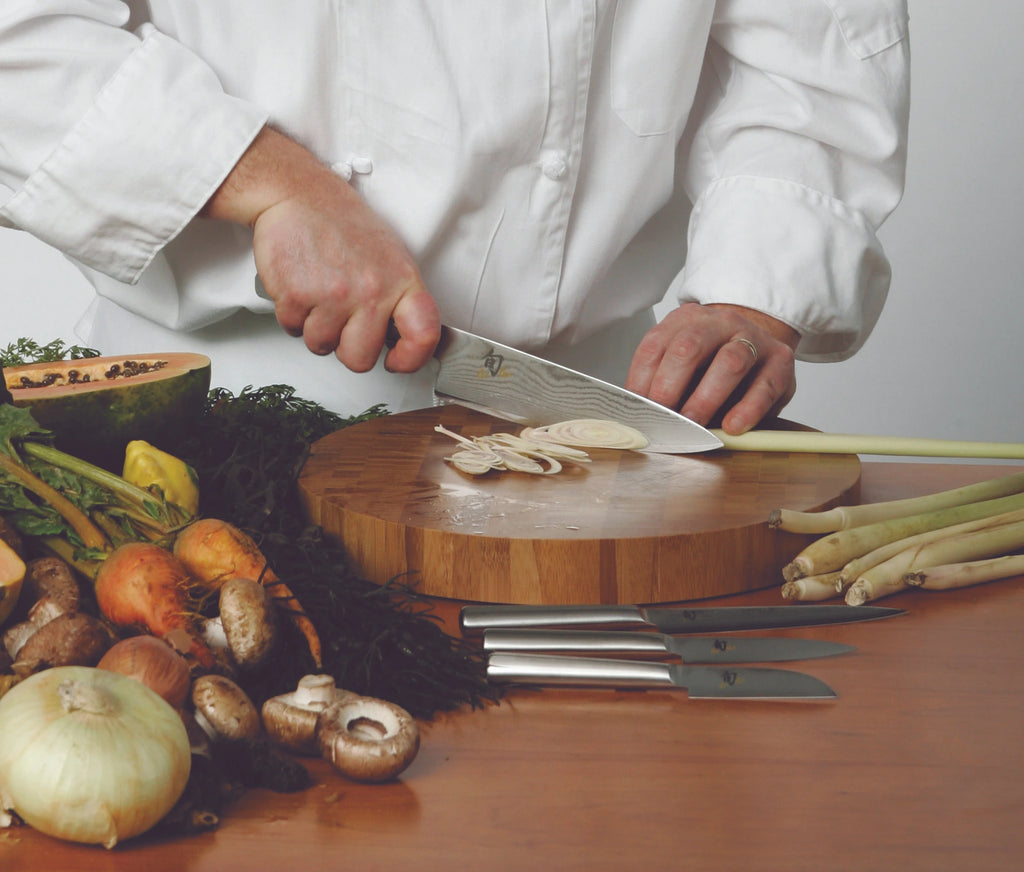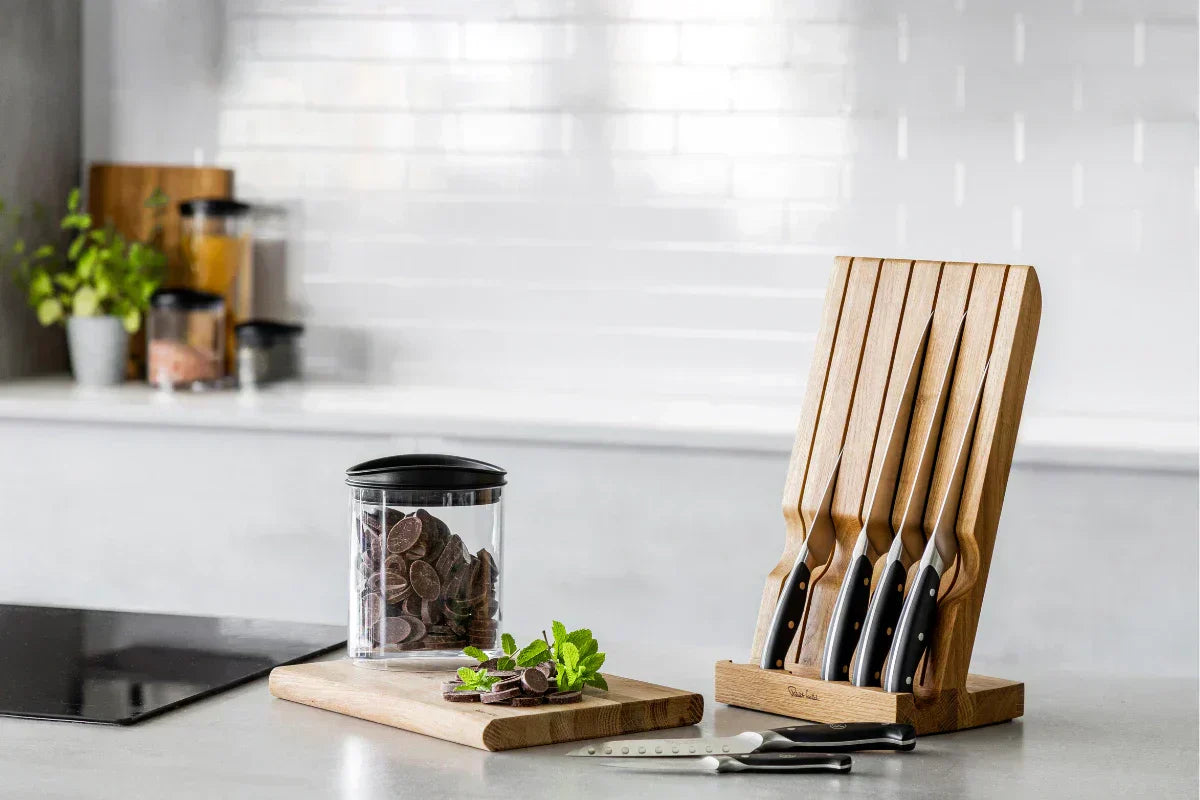When To Use A Chefs Knife - Full Guide To The Chef's Knife

What is a Chef's Knife?
A chef's knife, also known as a cook knife or a French knife, is a multi-purpose kitchen tool characterized by its broad, sturdy blade and sharp edge. It is the workhorse of the kitchen, capable of tackling a wide range of tasks, including chopping, slicing, dicing, and mincing. Its blade length ranges from six to twelve inches with a curved blade that tapers into a sharp point. With its versatility and efficiency, a chef's knife becomes an extension of the cook's hand, making it an essential tool in any culinary endeavour. With that knowing when to use one and choosing the right one is for you is essential.
In this blog post, we will cover all aspects of the chef's knife, their history, and origins, and most importantly, when and how to use them effectively in various culinary scenarios.
History & Origins Of The Chef Knife
The history of chef's knives dates back centuries. Known for originating in France, these knives were initially crafted for professional chefs who needed a reliable tool to handle various ingredients with precision. However, The chef's knife finds its lineage in ancient times, originating from a blade known as the "gyuto" in Japan. The gyuto, a predecessor to the modern chef's knife, was originally crafted by skilled Japanese swordsmiths who applied their centuries-old techniques to create culinary tools. What makes this historical connection remarkable is the shared philosophy behind the craftsmanship. Just as the samurai sword represents precision, artistry, and dedication to perfection, the chef's knife embodies these very principles in the realm of culinary arts. The meticulous attention to detail, the pursuit of flawless balance, and the commitment to excellence resonate in both the samurai sword and the chef's knife. Over time, the art of Japanese knife-making and the principles of their blade construction techniques migrated to Europe, particularly to France. There, the French embraced the spirit of the chef's knife, refining its design and adapting it to suit their culinary practices. The combination of Japanese craftsmanship and French culinary ingenuity birthed the modern chef's knife as we know it today with tweaks being made to it throughout the world.
When To Use A Chef's Knife
A chef's knife is an indispensable tool in the kitchen, but knowing precisely when and how to utilize its versatility can elevate your culinary skills. Understanding the optimal moments to reach for your trusted chef's knife can make a significant difference in your cooking experience. Let's explore the various scenarios where a chef's knife truly shines:
Preparing Ingredients with Precision: When it comes to chopping, dicing, and mincing ingredients, a chef's knife is unparalleled. Its broad, sharp blade and ergonomic design allow you to execute precise cuts, ensuring uniformity in size and texture. Whether you're finely dicing onions for a sauté, julienning vegetables for a stir-fry, or mincing garlic for a flavourful sauce, this knife is your go-to tool for impeccable ingredient preparation.
Tackling Tough and Sturdy Foods: When faced with tougher foods like butternut squash, melons, or large cuts of meat, a chef's knife's strength and weight come into play. Its sturdy construction and sharp edge make it ideal for effortlessly slicing through challenging textures.
Creating Beautifully Thin Slices: Whether you're slicing delicate proteins like fish or meat, or effortlessly creating paper-thin cuts of vegetables, a chef's knife is designed to deliver razor-thin slices. Its long, slender blade enables you to glide through ingredients with minimal resistance, achieving professional-looking results.
Handling a Wide Range of Kitchen Tasks: From disjointing poultry to crushing garlic cloves, a chef's knife can handle a plethora of kitchen tasks. Its versatility eliminates the need for multiple specialized knives, streamlining your workflow and ensuring you always have the right tool at hand.
Chef Knife Techniques & When To Use Them
Technique 1: Rocking Motion
The rocking motion is a fundamental technique used with a chef's knife, allowing for efficient chopping, mincing, and dicing. Follow these steps to master the rocking motion:
Start with a firm grip on the handle, ensuring your fingers are curled around the handle for control and stability.
Position the tip of the knife on the cutting board, slightly raised above the surface.
Using a gentle downward motion, bring the blade down while simultaneously moving the handle towards the cutting board.
As the blade makes contact with the cutting board, pivot the knife on the back edge, creating a rocking motion.
Lift the blade slightly, maintaining contact with the cutting board, and repeat the motion to continue chopping or mincing.
When to use the rocking motion. It is particularly useful when preparing herbs like basil or parsley. By utilizing this technique, you can quickly and evenly chop the herbs, releasing their aromatic oils and enhancing the flavour of your dishes.
Technique 2: The Claw Grip
The claw grip is an essential technique for ensuring safety and precision when using a chef's knife. This technique involves using your non-dominant hand to hold and guide the ingredients while keeping your fingers protected. Follow these steps to employ the claw grip:
Curl your non-dominant hand into a claw-like shape, tucking your fingertips under and resting them against the side of the ingredient you're cutting.
Hold the ingredient firmly but gently, maintaining a stable grip while keeping your fingertips away from the blade.
Use your guiding hand to move the ingredient towards the blade, applying controlled pressure as you cut.
The claw grip is particularly valuable when slicing onions. By using this technique, you can maintain precise control over the onion, reducing the risk of accidents while achieving consistent, thin slices.
Technique 3: The Tap Chop
The tap chop is a lesser-known technique that combines precision and finesse to handle delicate ingredients. It involves using the tip of the chef's knife to create small, controlled chopping motions. Here's how to execute the tap chop:
Hold the knife near the bolster with your dominant hand, ensuring a secure grip.
Position the tip of the knife on the ingredient you want to chop, applying light pressure.
With a quick, downward motion, tap the tip of the knife on the ingredient, creating a small chopping motion.
Repeat the tapping motion, gradually moving the knife across the ingredient to achieve desired results.
The tap chop technique is ideal for finely chopping ingredients like garlic or fresh herbs. By delicately tapping the knife's tip, you can finely mince the ingredients without bruising or crushing them, preserving their flavours and textures.
By mastering these techniques, you can unlock the true potential of a chef's knife, elevating your culinary skills and creating culinary masterpieces with finesse and precision.

Factors to Consider When Choosing the Right Chef's Knife
Selecting the right chef's knife can greatly impact your cooking and how you prepare your next dish.
Here are a few factors to consider:
Blade Material:
High-Quality Stainless Steel blades are popular due to their resistance to rust and corrosion. They are easy to maintain and provide excellent durability.
Carbon steel blades offer exceptional sharpness and edge retention. However, they require more maintenance to prevent rusting.
Blade Length:
Six to Eight Inch Blades: These shorter blades offer better control and manoeuvrability, making them suitable for intricate tasks like mincing and peeling.
Nine to Ten Inch Blades: Longer blades provide more leverage and are ideal for slicing and chopping larger ingredients with ease.
Handle Design:
Look for a handle material that offers a comfortable grip and is resistant to slipping. Common options include wood, composite materials, and synthetic materials like polypropylene.
Consider the handle's shape and design. It should fit comfortably in your hand, allowing for extended periods of use without causing fatigue or discomfort.
Choose a handle size that matches your hand's dimensions. For larger hands, a knife with a larger handle will provide a more secure and comfortable grip.
Weight and Balance:
The weight of the knife affects its balance and manoeuvrability. Some prefer heavier knives for added power, while others prefer lighter knives for increased agility.
Look for a well-balanced knife, where the weight is evenly distributed between the blade and the handle. This ensures better control and reduces strain on your hand and wrist.
Maintaining a Chef's Knife
Proper maintenance is essential to keep your chef's knife performing at its best. Here are a few maintenance tips:
Handwashing:
Always wash your knife by hand with warm, soapy water immediately after each use.
Avoid soaking the knife in water or leaving it unwashed for extended periods, as this can lead to corrosion or damage.
Proper Drying:
After washing, thoroughly dry the knife with a clean towel to prevent moisture build up and potential rusting.
Pay extra attention to the area where the blade meets the handle, as water can accumulate there.
Safe Storage:
Store your chef's knife in a knife block, magnetic strip, or sheath to protect the blade from damage and prevent accidents.
Avoid storing it in a cluttered drawer where it can get scratched or cause injury when reaching for it.
Honing:
Regularly hone your chef's knife using a honing steel or ceramic rod. This process helps realign the blade's edge, maintaining its sharpness.
Hold the honing rod vertically and at a slight angle, then glide the knife's edge along the rod in a sweeping motion, starting from the heel to the tip. Repeat this process several times on each side of the blade.
Sharpening:
Periodically sharpen your chef's knife to restore its sharpness. This can be done using a sharpening stone or a knife sharpener.
Follow the manufacturer's instructions or seek guidance from a professional if you're not familiar with sharpening techniques.
Remember to maintain a consistent angle and apply gentle pressure while sharpening to achieve the desired results.
Proper Cutting Surfaces:
Use a cutting board made of wood, bamboo, or plastic. Avoid cutting on hard surfaces like glass, ceramic, or stone, as they can dull the knife's edge.
Additionally, use a separate cutting board for raw proteins to prevent cross-contamination.
Safe Handling and Cutting Techniques:
Avoid using your chef's knife to cut through bones, frozen foods, or hard materials, as this can cause damage to the blade.




